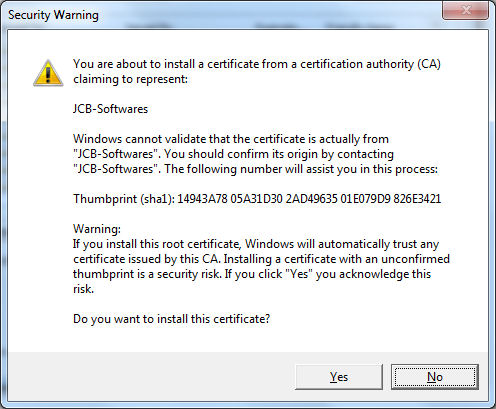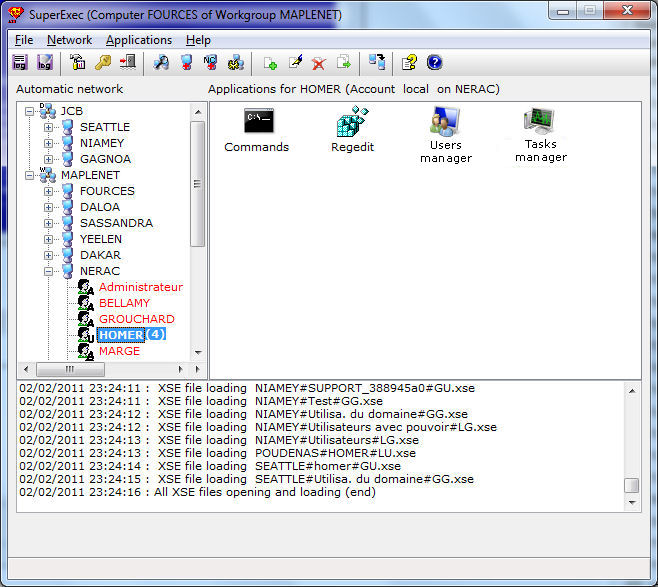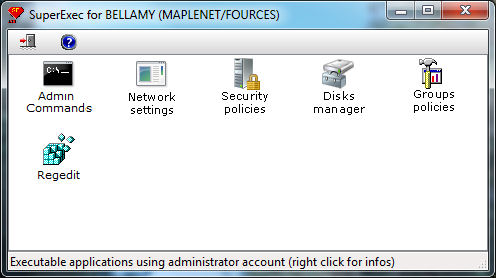Application launching using administrator
account
 Principles
Principles
Some applications or different tasks need to be
performed with administrator account privileges. However if the current
user does not belong to this group, this is impossible. To work around this
problem, Microsoft has provided three tools:
- SU.EXE in the Resource Kit NT
- RUNAS.EXE (integrated in Windows since Windows 2000).
- The contextual command "Run as Administrator"
| The major problem
posed by these tools is that the administrator must be
present physically close to the computer of the user, in order
to interactively enter its name and password (and if the
administrator communicates this information, it is not suitable for
the system security). |
In particular, neither SU nor RUNAS do allow
to integrate into a command administrator password, that must be entered
dynamically (with the exception of RUNAS in Windows XP PRO, with the /savecred
switch, which allows to remember this password for later execution).
The xrunas.vbs
script I wrote overcomes this difficulty, but security is considerably
compromised, since the administrator account password will appear clearly
in the script.
This is why I developped SUPEREXEC, utility
software (written in Delphi 7, then Delphi 2006),
which avoids to enter password in real time, while improving the system
security.
SUPEREXEC is running within following
operating systems :
- Windows 2000 (Professional and Server)
- Windows XP (Professional and Home Edition)
- Windows 2003
- Windows Vista
- Windows 2008
- Windows 7
It does not run within Windows NT4 because some functions
(cryptography, process management, network management) are not available.
|
SUPEREXEC frees this constraint, preparing application launching.
It records in
XML file (.XSE extent) following informations (fully
encrypted) :
- User account (or users group) – local or global (domain)
- Application name
- Parameters passed to application
- Working folder
- Administrator account and password
- Extra optional parameters :
- Launching deadline
- Launching counter
Application launching will be refused if:
- Application is not authorized to user or a group where user is a member.
- A deadline has been defined, and the current date is no longer valid.
- A counter has been defined, and the count is exceeded.
On the other hand, SUPEREXEC works remotely, and can manage in
the same manner as local any computers members of accessible domain or
workgroup.
In this case, all necessary files (XSE files, softwares, certificate, shortcuts
on the desktop, …) can be copied on remote computers with a single click .
 It has even
provided the case of disconnected from the network computers (eg
"nomads" users). It has even
provided the case of disconnected from the network computers (eg
"nomads" users).
All necessary files are automatically sent by email in the form of
unique compressed and enclosed file. |
Comments :
- Because of intrinsic network restrictions within Window XP Home Edition,
SUPEREXEC is able to work locally only and not remotely within a computer using
this system.
- Another workgroup or domain browsing needs some time.
So it is
possible to define network area :
- local computer only
- network manual building
- automatic network building (domain or group local) from a given IP
address range.
- • It is possible to select users group account instead of single
user account. So allowed applications to
this group will be authorized to any account member of this group.
- Selected applications must be located on current computer.
- SUPEREXEC is fully compatible with
UAC (User Account Control) in
Windows Vista, Windows 7 (and beyond).
- In case of console application (ipconfig, nbtstat, net xxxx, ...), it will be
launched using a dynamically created script in order to keep opened window until
user closes it.
- With regard to remote computers, SUPEREXEC enables remotely:
- registry access service
- administrative shares
SUPEREXEC software contains following files :
| SuperExec.exe |
main program, for administrators only, intended to plan
applications. |
| RunSE.exe |
run time program, for any users, intended to launch
applications. |
| InstSE.exe |
setup program for asynchronous mode (sent by email) |
| SuperExec.cer |
authentication certificate. |
| CAPICOM.dll |
Microsoft redistribuable library, used by digital signatures (V
2.1.0.2) |
| <language code>\SuperExec.lib |
localized file. It contains all messages, texts ... in several
languages. |
| <language code>\SuperExec.chm |
this help file. |
| SuperExec.rtf |
this document in RTF format |
| Licence.rtf |
license of this software |
In order to guarantee their origin, all SuperExec executables (SuperExec.exe,
RunSE.exe, InstSE.exe) are certified by a self-signed by
the author certificate.
The first time that one of these programms is launched, this opens the
following dialog box:

|
Numeric fingerprint (SHA1) of this certificate
must be necessarily equal to : |
|
1494 3A78 05A3 1D30 2AD4 9635
01E0 79D9 826E 3421 |
This information can be found in the "Digital Signatures" tab of
properties of executable files.
 Applications
preparation (administrator mode)
Applications
preparation (administrator mode)
SUPEREXEC works together
locally and remotly, so it is possible to manage in the same way
local computer and any workgroup or domain computer.
SuperExec main window is a dialog box, with a menu and buttons
toolbar, and 3 areas (network, applications, log) :

See help compiled file
SuperExec.chm
(this file is supplied with software)
 |
Pay special
attention to applications choice!
As far as possible You must avoid authorize applications
that launch other
applications, because they will be launched too with
administrator privileges.
For example if we authorize commands processor (%systemroot%\system32\CMD.EXE),
user will be able to launch any software, script, snappin
component, ..., with administrator power. |
|
 Applications
launching (user mode)
Applications
launching (user mode)
The SuperExec client application (runtime) of SuperExec consists of a main
dialogbox :

Each icon represents an application will be run under an
administrator account , and in case of Vista and beyond with active
UAC (user account control), as an administrator (with elevated
privileges).
Right click on one of the icons displays a popup menu with 3 items:
- run
its action is identical to double-clicking the icon.
- the application is running as an administrator
- create a shortcut
- an application shortcut is created:
- on the current user desktop if user account concerned by
SuperExec is an individual account
- on all users common desktop if account concerned by SuperExec is
a users group.
- properties
Displays a list of the application properties :
- file path
- associated executable name (optionally)
- optional parameters
- application type (console or windowed application)
- description
- working folder
- optional limitations (deadline and/or launching executions number)
- administrator account name
- optional comments
 It is also
possible to create a shortcut on the desktop by "drag and drop" on the
icon.
It is also
possible to create a shortcut on the desktop by "drag and drop" on the
icon.
 Download
and setup
Download
and setup
SUPEREXEC is completely free.
It is installed (under an administrator account) from an auto
extractable file : installSE.exe
(itself included in a compressed file : installSE43.zip)
All programs, including the Setup program, are currently bilingual
french and english.
 History
History
- march 2011 - Version 4.3.3.342
- 2004 à 2011 : full rewriting period
- use of XML files to store information
- network browsing by IP addresses range, instead of NetBIOS
request (often too slow)
- UAC (User Account Control) support
- insertion of a SMTP client and a ZIP component for datas
and softwares sending by email
- encryption algorithm strengthening.
- all software certification
- InnoSetup using as Setup program
- client application fully redesigned (drag and drop, UAC,...)
- 17/12/2004 - Version 3.0.1.237
- Network feature : network browsing (de)activation
- Bilingual application (only one software)
- Help file : SuperExec.chm
- New interface :
- menus bar
- buttons bar
- All settings in one dialog box
- Popup informations windows (network, accounts, applications)
- Operations log using HTML format
- Applications choice
- Account feature : local accounts may be disabled in
case of domain computers.
- MSI packages
- Profile may be :
- user account
- administrator account
- default account
- In case of user groups, we can insert application
launching into logon script on domain controller (NETLOGON share) or
in a local starting script (%systemroot%\system32\GroupPolicy\User\Scripts\Logon
folder).
- 02/02/2004 - Version 2.0.1.136
- GENERAL account removed, replaced by groups
management.
- Software splitting in 2 programs (SuperExec.exe
to prepare aplications, SE.exe to launch applcations)
- Profile user choice
- Working folder choice
- Application on remote computer different on target
computer.
- Shortcuts on :
- Desktop
- Start menu
- Registry (HKCU\Software\Microsoft\Windows\CurrentVersion\Runonce)
- Console application script dynamically created.
NB: it is created in %systemroot% folder, and only administrator can
modify it.
- 10/12/2003 - Version 1.5.1.89
- Manual computer name entry (hidden computer)
- Application parameters field;
- Console application launching using automatic
script.
- GENERAL virtual account (= any account).
- 03/12/2003 - Version 1.4.1.84
- Global accounts (domain)
- Shortcut caption customization.
- 13/11/2003 - Initial version
 Call
for translators
Call
for translators
All SuperExec executables have been designed to be
translated into any language.
All menu items, dialogbox,
information or error messageboxes, ..., are stored in a single text
file (superexec.lib) located in a subdirectory of one
containing executables.
The name of this subdirectory is the corresponding
language code in hexadecimal.
E.g. 0409 for English, 040C for French,...
There exists a list of these codes and their meaning in the key:
HKEY_LOCAL_MACHINE\SYSTEM\CurrentControlSet\Control\Keyboard Layouts
The SuperExec.lib file has the following structure:
- The 1st line is necessarily of the form:
SuperExec.lib#xxxxxxxx
xxxxxxxx is the name of the language (Français, English,...)
- The following lines are all of the form:
xxxxx.yyyyy .zzzzz = aaaaaaaaaaaaaaaaaaaaaaa
- xxxxx.yyyyy.zzzzz is an ID of menu,
message, field dialog...
It is composed of 3 words separated by dots.
It should not be changed.
- aaaaaaaaaaaaaaaaaaaaaaa is its content in
the concerned language.
Examples:
- SuperExec.lib "français"
Form3.TabSheet1.caption=Application
et paramètres
Form11.btnRemoveClick.remove=Êtes-vous sûr de supprimer l'adresse "%s"?
- SuperExec.lib "english"
Form3.TabSheet1.caption=Application and parameters
Form11.btnRemoveClick.remove=Are you sur to remove "%s" address?
The content may contain one or more formal parameters that will be filled by the appropriate values.
These
parameters are represented by %s (string) or %u (unsigned integer)
The SuperExec.lib file contains approximately 500 lines.
Currently there are only english and french
versions..
I would therefore call for volunteers translators in other languages in order to
improve SuperExec deployment.
Thanks in advance... (please
contact me)



![]() It is also
possible to create a shortcut on the desktop by "drag and drop" on the
icon.
It is also
possible to create a shortcut on the desktop by "drag and drop" on the
icon.